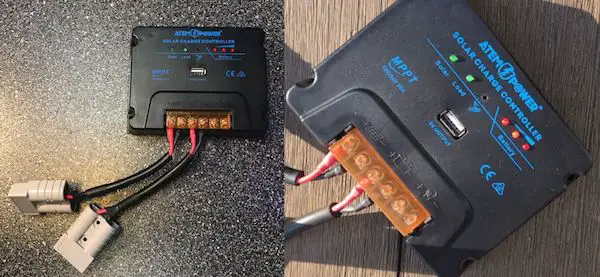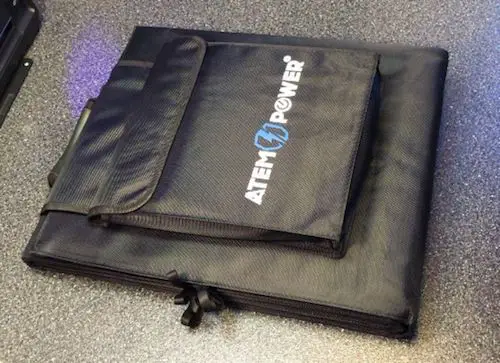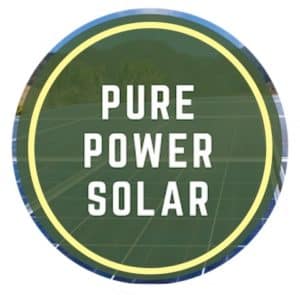After using solar panels to charge multiple portable power stations in my previous tests and reviews, I wanted to see what it would be like to use a solar panel to charge not only power stations but also individual batteries.
A company called VicOffRoad reached out to me to test their Atem Power solar panel that came with a charge controller, and I immediately bought my own battery to be able to test its charging capabilities out.
| Pros | Cons |
|---|---|
| Powerful output (rated at 200W) gives you ample power even in mediocre conditions | Heavy (panel is 17.4 lbs; with all accessories, it’s 21 lbs); not ideal for long-distance carry |
| Compact when folded (19.9 x 14.6 x 4.3 in); this is significantly more compact compared to similar panels | No legs to stand it up (comes with hanging loops only) |
| Charges batteries and portable power stations (comes with needed cables for both) | Very thin with several folding cells – needs to be secured properly to combat wind |
The Atem Power 200W solar panel is easy to carry and store due to its folding style. It charges most portable power stations and batteries with its included accessories. However, angling the panel requires some skill since it doesn’t have legs. Its versatility makes it ideal for off-grid charging.
This solar panel is ideal for car camping or van living since it can be stored easily when folded and comes with the accessories needed to charge batteries and portable power stations. Its hanging loops also let you mount it on the side or top of your vehicle.
Listed Specifications of the Atem Power 200W Solar Panel

| Voltage at Pmax (Vmp) | 18.3V |
| Current at Pmax (Imp) | 10.93A |
| Open-Circuit Voltage (Voc) | 22.5V |
| Short-Circuit Current (Isc) | 12.05A |
| Panel Weight | 17.4 lbs (7.9 kg) |
| Dimensions (Closed) | 19.9 x 14.6 x 4.3 in (505 x 370 x 110 mm) |
| Dimensions (Open) | 74 x 29.1 x 0.2 in (1,880 x 740 x 6 mm) |
Be sure to check your portable power station’s solar charging requirements because some may fall outside the Atem Power’s range (for example, my BigBlue CP500 cannot be used with this panel because its amperage requirement is much lower).
For battery recharging, check the max charging current and voltage specs to make sure the battery can get the full power benefits from the solar panel.
Example: In my charging test, I used a TalentCell 12V 24Ah LiFePO4 battery, and its max charging voltage (14.0-14.6V) and max charging current (10A) multiply together to get a maximum of 146W of charge. If the Atem Power panel produced more than this wattage, then the charge controller would limit the power to 146W and I’d miss out on additional power.
Similar: What Kind of Solar Panel Do You Need to Charge a 12v Battery?
How to Use Atem Power’s 200W Panel (Two Methods)

There are two charging methods I used in my testing. The first was with a 12V 24Ah LiFePO4 battery, and the second was with my EcoFlow River Max power station.
The power station doesn’t require the use of the Atem Power’s charge controller, but the battery does. The setup for charging a battery involves a few more steps to connect everything together properly.
Charging a LiFePO4 Battery Using Included 20A MPPT Controller

My TalentCell battery needed to be connected to the charge controller first before connecting to solar. My YouTube video shows exactly how this is done, but the steps are also listed below:
shows exactly how this is done, but the steps are also listed below:
- Connect the alligator clamps to the battery (negative first, then positive)
- Connect the Anderson end of the alligator clamps to the charge controller under the battery icon section
- Use the Anderson extension cord to connect the solar panel to the charge controller under the solar panel icon
After these steps are completed, you can successfully charge the battery.
Atem Power 20A Charge Controller Specifications
| Rated Charge/Discharge Current | 20A |
| Rated Voltage | 12V/24V auto work |
| Overload, Short-Circuit Protection | ≥1.5 rated current |
| No Load Current | <10mA |
| Over Voltage Protection | 16V; x2/24V |
| Voltage of Stop Charging | 14.7V; x2/24V |
| Discharge Recovery Voltage | 12.0V; x2/24V |
| Over Discharge Voltage | 10.8V; x2/24V |
| USB Output | 5V, 1A |
| Working Temperature | -31°F∼131°F (-35°C∼55°C) |
| Dimension of Controller | 5.16 x 3.92 x 1.16 in (131 x 99.5 x 29.5 mm) |
| Weight | 10.58 oz (300g) |
Charging With a Portable Power Station (Without MPPT)

The Atem Power panel comes with additional cables to connect to your portable power station. This method doesn’t require the MPPT controller because the portable power station already has one within it.
For my example when testing, I used my EcoFlow River Max power station to charge with the solar panel.
I received an average of 48W of power with a maximum of 56W in the following conditions:
- Cold weather (20-30 degrees Fahrenheit)
- Slightly hazy cloud cover
- Some shading obstructions from tree branches
Due to my poor testing conditions, my results were in the range of 25% efficiency. This was not a surprise. In ideal conditions, I would expect this panel to reach up to 160W. This would be in spring/summertime with the sun high in the sky.
The two cables used for power station charging are the Anderson (50A) to Anderson Powerpole (30A) connector and the Anderson Powerpole to DC5521, DC5525, DC7909, and Aviation adapters.
By connecting the Anderson Powerpoles to each other from each cable, you can connect the larger 50A Anderson adapter to the solar panel and one of the four power station adapters to an accompanying power station.
In my case, I only used the Anderson to Anderson Powerpole connector with my EcoFlow River. This is because it uses an XT60 input. I used an Anderson Powerpole to XT60 adapter (not included) to charge it up.
Similar: EcoFlow River 600 Review – Testing My River Max + Comparisons
Atem Power 200W vs. Similar Solar Panels
| Solar Panel Model | Atem Power 200W | Rockpals 200W | Bluetti PV200 | Goal Zero Nomad 200 |
|---|---|---|---|---|
| Image | ||||
| Ideal Max Output (@ 80% Efficiency) | 160W | 160W | 160W | 160W |
| Folded Dimensions | 19.9 x 14.6 x 4.3 in | 21 x 24 x 2.4 in | 23.2 x 24.8 x 3 in | 28.2 x 22.3 x 2.0 in |
| Unfolded Dimensions | 74 x 29.1 x 0.2 in | 93 x 21 x 1.2 in | 23.2 x 89.2 x 0.75 in | 28.2 x 100.7 x 1.0 in |
| Weight (Panel Only) | 17.4 lbs (7.9 kg) | 18.3 lbs (8.3 kg) | 16.1 lbs (7.3 kg) | 22 lbs (10 kg) |
| Features | - Monocrystalline - 4-in-1 charging cable - Hanging loops - 20A MPPT charge controller - 50A Anderson extension cable - Alligator clips - 50A Anderson to 30A Anderson Powerpole cable - Carrying handle - Velcro pouch | - Monocrystalline - 4-in-1 charging cable - Built-in legs - USB-A QC 3.0 - USB-C - 2x APP ports - Carrying handle - 4x metal grommets - Zippered pouch | - Monocrystalline - 10ft MC4 connector - Built-in adjustable legs - Carrying handle - Zippered pouch - IP65 rated junction box | - Monocrystalline - 6ft APP charging cable - Built-in legs - 12W USB-A - Built-in mesh pocket - Hanging loops |
| Price | $290 | $300 | $430 | $600 |
There are three things that stand out the most to me when comparing the Atem Power panel to the others in this table:
- Dimensions (folded and unfolded)
- Features / add-ons
- Price
Comparing Dimensions
The other solar panels on this list fold only one way (horizontally) whereas the Atem Power folds both horizontally and vertically.
This allows the panel to be more condensed than the others when folded, and when unfolded, its width is shorter yet its height is taller.
Features & Add-Ons
As for features, all of the other panels have legs or kickstands but the Atem Power doesn’t. This is because the others are mainly meant for use on the ground. The Atem Power can be used flat on the ground but its best purpose is for mounting.
In terms of add-ons, the Atem Power panel comes with much more accessories than the competition. The other panels are meant to be used with these companies’ compatible power stations but (with adapters) can be used with other power station brands.
The Atem Power is meant to be used for various power stations as well as for battery charging and it includes the cables for both recharging methods.
Price Comparison

Comparing each panel’s pricing it is obvious that the Atem Power and Rockpals panels are similar and the other two cost significantly more.
The Rockpals panel has the ability to connect to different types of power stations with its adapter and it also has a kickstand, whereas the Atem Power panel doesn’t have a kickstand but comes with a similar power station adapter as well as all needed cables for battery recharging.
Overall, the panel that suits you best depends on your intended charging method and the way you mount or place the panel.
If you intend to recharge a battery, the Atem Power panel is the best choice because you don’t need additional gear. However, since it doesn’t have a kickstand, this panel should be mounted with its hanging loops.
Atem Power 200W vs. Other Solar Panels I’ve Tested
| Solar Panel Model | Atem Power 200W | Elecaenta 120W | BigBlue SP100 100W |
| Highest Output Recorded | 56W (poor conditions) | 98W (ideal conditions) | 71W (nearly ideal conditions) |
| Efficiency From Testing | 28% | 82% | 71% |
| Folded Dimensions | 19.9 x 14.6 x 4.3 in | 20.47 x 14.17 x 2.17 in | 24.9 x 21.3 x 0.7 in |
| Unfolded Dimensions | 74 x 29.1 x 0.2 in | 65.35 x 20.47 x 0.98 in | 24.9 x 42.5 x 0.2 in |
| Weight (Panel Only) | 17.4 lbs (7.9 kg) | 11.24 lbs (5.1 kg) | 8.2 lbs (3.72 kg) |
| Price | $290 | $180 | $200 |
Each solar panel listed above is rated for a different wattage. They all fold differently – they collapse in increasingly smaller dimensions from right to left (in terms of length and width):
- The BigBlue SP100 folds horizontally only once over
- The Elecaenta 120W panel folds four times horizontally
- The Atem Power folds four times over horizontally and once over vertically
Testing Conditions & Results for Each Panel

Unfortunately, I was not able to get a good testing environment for the Atem Power panel, but it was still able to produce 56W of power at its peak.
This is important for me because I can still get a good amount of watts on a cloudy day since the panel is significantly larger than the other two I’ve tested.
The Elecaenta panel produced the highest efficiency at 82% but also had the best testing conditions when I reviewed it in the summer on a clear day.
In terms of folded sizing, this panel is light and compact, however, as seen in my YouTube video , the Atem Power panel is slightly more compact than the Elecaenta panel in terms of length when folded.
, the Atem Power panel is slightly more compact than the Elecaenta panel in terms of length when folded.
The BigBlue SP100 was tested in the winter on a sunny day and produced a 71% efficiency (71W).
Although it may be able to produce a slightly higher wattage in better conditions, this panel is unlikely to produce ample power in poor conditions compared to the Atem Power panel due to it being half its size.
Although I do my best to test each solar panel to the best of my ability, sunlight, panel angle, shade, and several other factors come into play and can affect the panels’ performance.
Compatibility
In terms of compatibility, the BigBlue SP100 is meant specifically for the BigBlue CellPowa500 power station and doesn’t come with additional adapters.
The Elecaenta 120W panel comes with several different adapters for recharging portable power stations.
The Atem Power panel has fewer portable power station adapters than the Elecaenta panel, but the Atem Power has all the necessary equipment for recharging batteries while the others don’t.
Similar: Solar Generator vs Battery – Which Is Ideal?
Measuring the Portability of the Atem Power Solar Panel

Typically, a 200W portable solar panel is not very portable. Because the panel is so large, it tends to be large even when folded. This is where the Atem Power shines, however, because it folds several times over to be even more compact than my Elecaenta 120W panel (and this one is also compact).
However, this still is not good enough to be an easy backpack fit, as it is nearly the size of my own backpack. It is also heavy, as most 200W panels are, at over 17 pounds. If you add all of the accessories to its pouch, it is over 21 pounds.
I’m glad that the company included a nice carrying handle on the panel because it would be a two-handed pickup without it.
Thinking through other 200W panels like this, the Atem Power is probably one of the most compact 200W solar panels you can buy.
Ease of Use – From Folded to Recharging

The Atem Power is not as easy to use with batteries as is the case with compatible portable power stations. However, the package includes all that is needed to connect the panel to your battery.
As for portable power stations, as long as you have one that can connect to one of the four different adapters, the setup is quite simple.
You just need to connect the Anderson Powerpole connectors together from the two included cables. Then, hook up the panel and connect to your Jackery, Goal Zero, or whatever system you have that can connect.
Since the panel is very large when unfolded and doesn’t have built-in legs, you need to either lay it flat on the ground or hang it on something to charge from the sun.
This was a long process for me because even though it has several hanging loops, I didn’t have a place in my backyard to hang it up.
If you can’t hang the panel up on a car, tent, etc., then it’s going to be a difficult time standing it up at an angle.
Conclusion

Overall, the Atem Power 200W panel is a great option for someone needing portability, high power, and versatility with charging options (battery, portable power station, etc.).
I recommend this specific solar panel kit to anyone who will use it with a battery. If you only need it for a portable power station, I recommend getting one without a charge controller.
You can find all of my testing and further analysis in my YouTube review of the system below.
My contact at VicOffRoad (the company that provided me with this solar panel) mentioned that they might be offering the solar panel without the charge controller; however, it is not available at the time of writing this post.
Stay tuned on VicOffRoad’s solar panel listings in case they update the panel offerings in the future. I also recommend checking out VicOffRoad’s website if you’re looking for tools to improve the off-road capabilities of your car. They have all sorts of modifications including floor mats, wenches, lighting to name a few.
In the meantime, if you’d like a similar panel without the MPPT, I tested my Elecaenta 120W portable solar panel and really love it (I have two!). It’s both versatile (in the number of adapters) and powerful (got 98W out of it) at about 80-82% efficiency. Find my review and test here: ELECAENTA 120W Foldable Solar Panel Review (Testing & Comparison).




